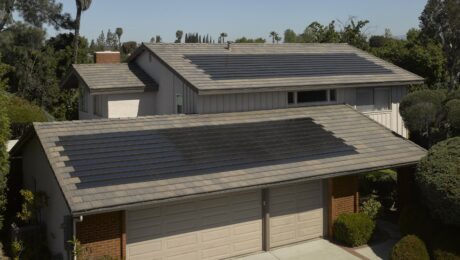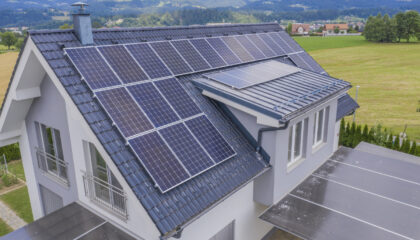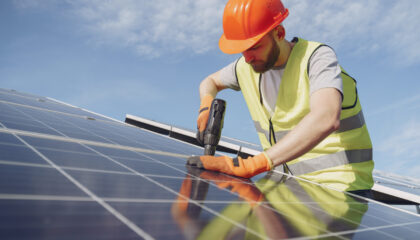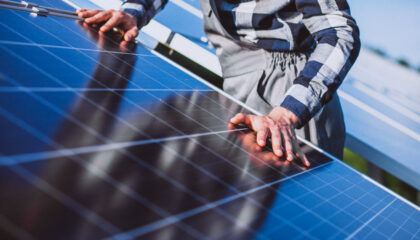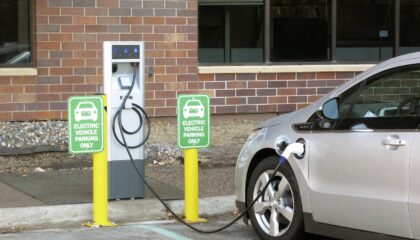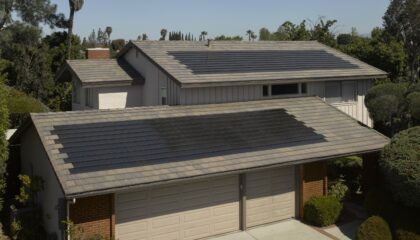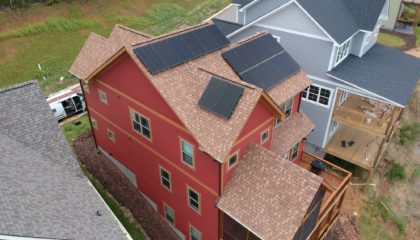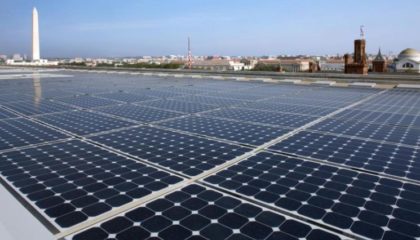Solar Shingles – Worth the Hype?
There has been a lot of buzz about solar shingles and solar roofs the last couple of years. Is this new(er) solar medium worth the hype? Most experts in the industry agree unanimously, NO.
Tesla’s famous roof tiles made their debut in 2016 where they were presented as a non-functional prop at Universal Studios. Since then, many people have gotten attached to the idea of a more aesthetically pleasing look. Unfortunately, our advice to those people is to forgo the hype and install traditional solar modules on their existing roofs for the following reasons:
- Despite misleading prototypes and mock-ups, so far there has not been a company that has successfully constructed a full-scale solar roof. Currently there are solar shingles in production, but they are not designed to replace an existing roof entirely, just a section as traditional modules would.
- Solar shingle installations are more difficult and expensive. Installers must be very meticulous in preventing roof leaks as they integrate the solar shingles with the existing roof shingles. Additional attention and materials must be used to layer water barriers between the roof sheet and the solar shingles. The added labor and level of expertise needed drives up costs significantly.
- The productivity and efficiency of solar shingles has not yet come close to traditional solar modules. On average, the thin-film solar cells from that which solar shingles are made are about 10-12% efficient. Traditional modules, made of polycrystalline or monocrystalline silicon, average 17-20% efficiency.
- The market for solar shingles is very narrow. Buyers must be building a new home, need a roof replacement, or have the capital to fully replace a functional traditional shingle roof.
- Advertising of solar shingles often states that they are less expensive than replacing your shingles; but this is not entirely truthful. The fine print of this statement typically compares the cost of solar shingles to the sum of replacing your roof several times over many decades.
There is no doubt that solar panels of the future will take different forms and that the technology will change and improve. Research and development from around the globe is producing many different, promising photovoltaic technologies. But, for now, what is readily available on the market, is our installation of choice. For those worried about aesthetics, we offer all black solar panels with black racking. If you ask us, it looks great and functionality is top notch.
Call us at (828) 332-3003 or Click Here for a free quote!
Cited Resources:
- Published in Solar Technology
IQ8 Microinverter and the all new Ensemble by Enphase
Enphase Energy’s Ensemble
Enphase’s newest and eighth generation microinverter, the IQ8, debuts with a new “grid agnostic” system. Enphase has now officially stepped into the hybrid PV system arena with energy storage under the name Ensemble. With convenient features like smart phone monitoring and virtual assistant integration with Alexa, Enphase is giving homeowners easy control and understanding of their system and its performance.
Ensemble’s AC battery provides you with energy during a grid outage, and continuous solar energy production. Solar production during an outage is crucial to recharge your battery and power loads in the home when the sun is shining. Whether you have an outage lasting hours or days, Enphase’s Ensemble is capable of powering you through.
Ensemble is expected to be released mid 2020 and will be compatible with existing IQ6 and IQ7 systems. If you have an existing installation and are interested in battery backup we’d be happy to provide you a quote.
Here’s an informative video by Enphase introducing Ensemble:
What is a microinverter?
A microinverter is a small inverter that typically connects to only one solar panel. A microinverter solar energy system will have a microinverter placed under, and connected to, each individual solar panel on your roof.
Why use a microinverter?
Microinverters offer several incentives over their string inverter counterparts: Microinverters are great at reducing the impact of shading. Should you have trees or structures casting shadows over your installation area micro’s will minimize the losses. Micro’s also operate completely independent of each other. Each solar panel then has the opportunity to reach peak performance without its neighbors bringing it down. In contrast, string inverters utilize strings of several solar panels all connected in series. When a solar panel in a strings’ performance is low it has the potential to bring down its neighbors with it; reducing the output of the whole string of solar panels.
Why use anything other than a microinverter?
Microinverters are a great option for smaller systems, say less than 10kW, where shading will be an issue and, formally, when battery backup was of no interest. On larger system installations microinverters quickly become more costly to install. There are other options to minimize shading losses, such as optimizers, when utilizing a string inverter for bigger solar energy arrays.
For more information check out other pages on our site:
How solar energy works
Solar FAQ
- Published in Solar Technology
Trash to Solar
As the need to distance ourselves from fossil fuels becomes more urgent due to climate change and pollution in general, solar power is emerging as a leading alternative. It can be scaled to be used by individuals or large utilities; and best of all- it’s renewable. However, large scale solar farms require large tracts of land that have long and regular periods of sunlight. Suitable areas can usually be found in many rural settings and deserts, but transferring that energy over lengthy power lines to more populated areas can be expensive and inefficient.
A new trend is emerging that seems like a promising answer to this inconvenience – building on retired landfills! When a landfill is full it is covered with a polyethylene cap, a thin layer of soil, and finally grass. Despite it’s more pleasing aesthetics, this brownfield ground is still mostly unusable as it is unstable and not suitable for building large structures. Because of the gasses and toxins emitted by the covered landfill the growing of crops is also not a viable option. However, this acreage is perfect for large scale solar farms. Ballasted anchors are used to stabilize the solar array to avoid penetrating the landfill cap. This specialized racking system allows for thousands of solar panels to be installed on this otherwise unusable land; producing a lot of clean, renewable energy.
Landfills are typically built outside of, but close to, city limits and already have access to the power grid. This makes transporting energy for use in more densely populated areas much easier. Right now, there is an estimated 10,000 capped landfills in the US alone, and that number is only growing. The construction of large solar farms would not only positively impact the environment, it would create thousands of well-paying and sustainable jobs on land that is otherwise sitting unused.
- Published in Climate Change, Solar Energy, Solar News, Solar Technology
Craft Brewers Going Solar
Craft brewers love to sell themselves as environmental activists. How can you tell a sincerely sustainable business from those looking for a selling point? One answer, solar.
The Relationship Between Brewers and Environmentalism
Millennials love craft brewers, and craft brewers are very aware of what the Pew Research Center found in 2014. Millennials look for socially and environmentally responsible businesses and are willing to pay more for sustainable products.
As Millennials are the biggest generation, marketing to them is important. Having a green (or green-washed) business brings in customers excited to support an environmentally-friendly organization.
Craft brewers also must combat the fact that they are a water-intensive industry; a gallon of beer from an average brewery requires seven gallons of water. While most customers would still drink their favorite brew despite the water consumption, water availability and quality are growing environmental concerns directly affecting and affected by breweries. An organization marketing to an environmentally-conscious generation needs to balance environmental cons with environmental pros.
Follow the Money
While craft brewers modify their businesses and processes in a variety of ways to become more sustainable, a customer dedicated to finding the most sustainable beer needs only to follow the money. Businesses who make investments in environmentally-conscious practices are using part of their profits for a greater cause.
A great way to invest in the environment is installing solar arrays. Of the 6,000 American craft breweries, only 100-150 have solar arrays, and ten of those call North Carolina home.
Check out some local breweries going beyond greenwashing
SolFarm Solar Co. has installed solar energy systems at Apothecary Beverage and Buchi Kombucha. Visit their sites to learn more about their brands.
- Published in Climate Change, Solar News, Solar Technology
Solar Trumps Coal Environmentally and Economically
In a competitive market, coal is more expensive than both solar and wind.
In 2001, Texas created a competitive electricity market in that the least expensive resources go on the grid first. At that time, wind supplied less than one percent of Texas’ energy. As of 2018, 20 percent of the market is wind power. With technology and increased production lowering the cost of renewables, there are less arguments, than ever before, for the steady destruction of mountainous landscapes created by America’s need for coal.
Due to the competitive market, Texas has retired coal-fired plants, replacing them with natural gas which is significantly less expensive. By the end of next year, wind is expected to generate more electricity for Texans than coal as more plants are retired. However, these retired plants are largely being replaced by more efficient and less expensive natural gas plants. While natural gas beats coal in an environmentally-friendly competition, it is still a fossil fuel.
Texas’ competitive electricity market creates a fairer fight between renewables and fossil fuels when compared to other state and federal energy policies. Still, fossil fuels have an advantage. The hidden costs related to fossil fuel use like the consequences of climate change, explosions during drilling, transportation, spills and leaks, or burning process, and the pollution of land surrounding gas wells, is not included in the price comparisons of natural gas and renewables.
However, there is still hope. As we continue to burn the finite source of natural gas, it will face the same, inevitable dilemma of oil and coal. The low hanging fruit will be harvested, and the remaining sources will be difficult, dangerous, and expensive to gather while the cost of renewable energy continues to plummet. Someday, the market will favor it.
Will the invisible hand of the free market move soon enough? Don’t wait to see. Ease America’s dependency on fossil fuels by making a personal change in your energy source. Contact SolFarm Solar Co to see what you can do to save the planet.
- Published in Climate Change, Policy, Solar Energy, Solar News, Solar Technology
Solar Innovations to Change the Game
New solar innovations pop up in the growing industry on a regular basis. Sometimes, innovations just improve efficiency by fractions of a percent, quietly helping in the climb toward higher efficiency.
However, several new findings put higher efficiency on the horizon of solar panels with flashy recreations. Today, according to Energy Sage, the best solar panels convert about 22% of absorbed sunlight into energy and cost $2.87 to $3.85 per watt.
Silicon Replacement
Agency of Science Technology and Research created a compound to replace silicon. In the average solar panel, silicon converts sunlight to energy. Before now, the only possible replacement was toxic Tulluride. The compound, called CZTS, an acronym for copper-zinc-tin-sulfide could change the game of solar panels with 30% efficiency.
Korean scientists also discovered a possible replacement. Perovskite is an element that can convert sunlight to energy, but it is very unstable. Scientists added flourine to protect the perovskite layer from moisture which causes it to degrade. The panels are not perfect yet, but perovskite is more efficient than silicone. They may be the panels of the future.
Transparent Solar Panels
With new transparent solar panels, solar energy may be produced where it could not be before. Unlike the familiar silicon panels seen on roofs, these panels only absorb invisible light. On the bright side these panels can be put on any windows, smart phone screens, or any clear surface. If solar panels covered all the glass in America, these transparent panels double the potential energy solar could offer, making up almost 80% of the national energy demand.
Better Batteries
Scientists work to improve storage batteries as well as panels. Storage batteries moved the solar industry into new territory of microgrids, an innovation themselves. Storage batteries are lithium batteries. Scientists at Berkeley found materials store Lithium in ordered and disordered fashions. Currently, batteries are made with materials that order lithium and other materials in neat layers. However, disordered organization stores more lithium. Scientists identified a criterion to use in predicting how materials will organize lithium. They also found adding flourine increases storage, stability, and fire safety.
It Takes Time
As exciting as these innovations are, they won’t make a splash immediately. New ideas often cost more. Solar roadways hit the market last December. However, the first project sold for $5.2 million for a kilometer length road. Like the very first solar panels, cost is not always effective, but with time and even more innovation, these great tools will be available for the average homeowner or community.
The cost of solar panels continues to fall, and hopefully, CZTS, transparent solar panels, and even solar roads follow the same trajection. A future is possible where solar is a part of what we drive on or in, our windows, and even our touch screens. It just requires more innovation.
- Published in Solar Technology
- 1
- 2

